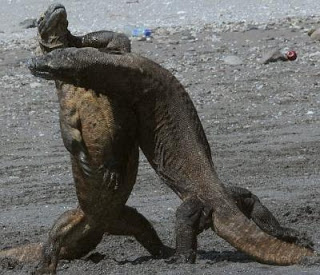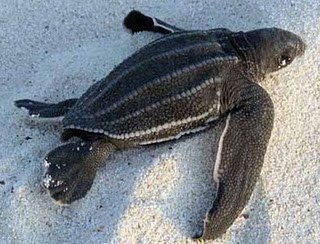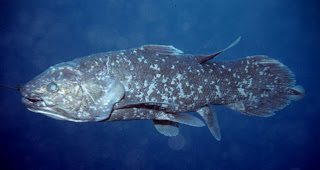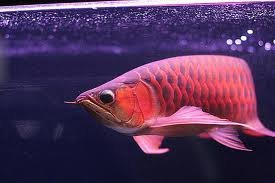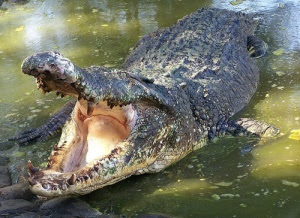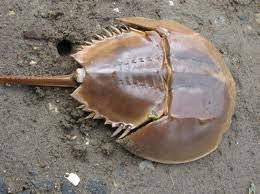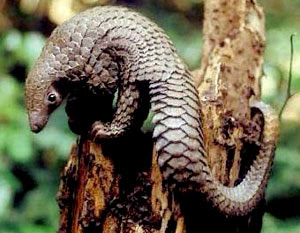7 Ancient Animals In Indonesia Who Still Live Up To Now
If we want to see ancient animals then we will only see it in the form of fossils because the ancient animal was extinct millions of years ago. But it turns out among the ancient animals that can still be found some ancient animals that are still living on this earth, including in the territory of Indonesia.
Animals thought to be extinct but apparently still exist can be called living fossils. Living fossils are the name for animals or plants that are considered extinct and become fossils, but in fact are still alive. This title can also be applied to animals / plants that are known to have existed millions of years ago with a form that has not changed much with the fossil remains.
(1) Komodo
Komodo is an endemic species of primitive reptiles that lived since ancient times. The evolution of the Komodo dragon begins with the genus Varanus which began developing in Asia between 40-25 million years ago. Komodo dragons are close relatives of dinosaurs. This is seen from the discovery of fossils of certain types of dinosaurs that show the resemblance of body structure with dragons. Dinosaurs have long been extinct but Komodo is still there. Komodo is called the last dinosaur in the world. This one-time animal with dinosaurs is known as a carnivorous lizard but they are also cannibal animals because sometimes they prey on their children. Komodo (Varanus komodoensis) is the largest type of lizard. The largest recorded ever Komodo has a length of 3.13 meters and weighs 166 kilograms. Komodo dragons can be found on Komodo Island and the surrounding small islands in East Nusa Tenggara Province. The native Komodo habitat can only be found in the Indonesian archipelago and not in other parts of the world.
(2) The leatherback turtle
Leatherback or Dermochelys Coriacea is said to have inhabited Earth since 100 million years ago when dinosaurs ruled the planet. The leatherback turtle is the largest turtle species. The weight of leatherback turtles can reach 900 kg, with a body length of about one and a half to two meters. Unlike other turtles, leatherback turtles do not have hard carcasses. Its carapace is like a mosaic of small hard bones, its skin is elastic with a longitudinal back. Leatherback turtles can be found from tropical waters to the oceans of the sub-polar regions and usually lay their eggs on the beaches of the tropics. Leatherback turtles eat only the jellyfish, and there are few places in the world that he chooses to spawn. One of the spawning places is on Jamursba Beach Medi and Warmon is located in North Birds Head of West Papua Province, Abun District, Tambrauw District. Leatherback turtles have a habit of traveling the world exploring different regions of the hemisphere.
(3) Coelacanth
Coelacanth is thought to have existed since the Devonian era about 380 million years ago, until now its form has not changed. Coelacanth is an ancient fish that comes from a branch of the oldest surviving evolution of jawed fish. Previously, the fish had been estimated extinct since the end of the Cretaceous 65 million years ago. But then it turns out this fish is found still alive. These fish live only in the waters of western South Africa and the waters of eastern Indonesia are each called Latimeria chalumnae and Latimeria menadoensis. In Indonesia Coelacanth ancient fish can be found in the waters of Talise, North Minahasa and the waters of Malalayang, Teluk Manado, North Sulawesi. Coelacanth Fish habitat is located more than 180 meters deep with a maximum temperature of 18 degrees Celsius. In Indonesia, especially around the waters of Manado and North Minahasa, this species by local people is named after the sea king fish.
(4) Arwana
Arwana is one of the ancient fish that has not been extinct. Genetic studies and fossil findings show, these fish have at least been living on earth since 220 million years ago. Arwana including carnivor fish that inhabit the habitat of rivers and lakes are calm water. These fish can be found in the Amazon, and in parts of Africa, Asia and Australia. Arowana fish (Scleropagus sp.) Can be found in Indonesia's bargaining waters. One type of Arwana is Arowana super red which is the original fish headwaters Kapuas River and Lake Sentarum in West Kalimantan. These waters are the areas of peat forest that create a primitive environment for these ancient fish.
(5) River crocodile
Crocodile is one of the earliest animals left on earth. Crocodile crocodile or crocodile crocodile (Crocodylus porosus) is one of the largest crocodile species in the world, much larger than Nile Crocodile (Crocodylus niloticus) and Alligator America (Alligator mississipiensis). The length of the body including the tail can reach 12 meters as found in Sangatta, East Kalimantan. Crocodiles still have close relatives with ancient reptile animals, CrocodileSaurus is a crocodile ancestor that has a length of nearly 30 meters. But due to the influence of nature, CrocodileSaurus body shrinks to become a crocodile estuary. Crocodile estuaries can be found starting from the Bay of Bengal (India, Sri Lanka and Bangladesh) to the Fiji Islands. Indonesia became the most favorite habitat for estuarine crocodiles besides Australia
(6) Belangkas
Animals that resemble crabs are animals of the type of artopoda living in shallow waters and mangrove areas. Sometimes called the name of horseshoe crab, mimi, or mintuna. Mimi is the name in Javanese for the male and Mintuna is for the female. This animal is one of the earliest animals that did not undergo any significant shaping since Devon (400-250 million years ago) compared to its present form, although the species are not the same. This animal shape is shaped like a horseshoe horseshoe. Despite its creepy shape, bacon and eggs can be used as food. But need to be careful because there are parts of his body that contain toxins. It can be found in the waters of Southeast Asia and North America. In Indonesia, the types of crops found are Tachypleus gigas, Tachypleus tridentatus and Carcinoscorpius rotundicauda. T. gigas species are found in estuary waters almost evenly throughout the Indonesian waters.
(7) Pangolin
Pangolins belong to one of the earliest animals, some of the fossilized pangolins have been found during the Oligocene and Miocene periods. These animals feed on insects and especially ants and termites. His hair was modified into a kind of large scales arranged to form a layered shield as a means of self-protection. If disturbed, the pangolin will curl up like a ball. Pangolins live in lowland tropical rain forest. Pangolin can be found in Southeast Asia. Pangolins in Indonesia known as Trenggiling Jawa (Manis Javanica) are found in mountainous areas of Sumatra, Kalimantan and Java and Bali. Although it looks like a reptile, this animal belongs to a mammal. Now in Indonesia alone these animals include protected animals. In Jambi Province the pangolin population is still quite common.
